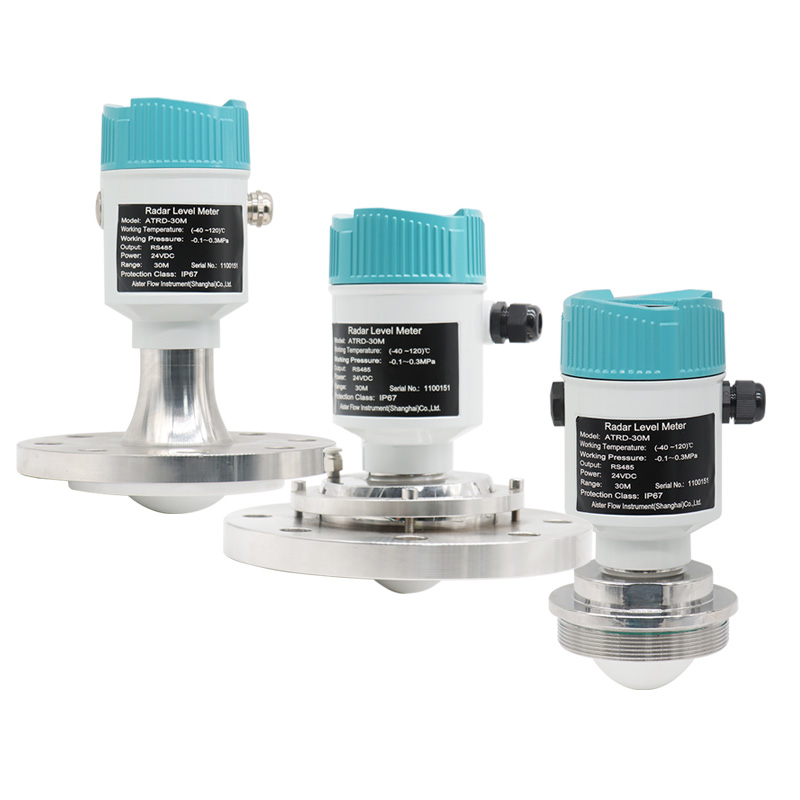How do radar level meter measure oil levels in fuel tanks?
2024-05-13
Fuel tanks are important fuel storage facilities, and accurate oil level measurement is directly linked to the management and security of the energy supply. Consequently, the use of highly accurate and reliable measurement technologies to monitor fuel levels in tanks is an important element in ensuring the continuity and security of the energy supply. Among the many level measurement technologies, the radar dipstick has become an optional piece of equipment for measuring oil levels in fuel tanks, due to its advantages such as non-contact measurement, high accuracy and high stability.

Fuel has a high dielectric constant, which affects the propagation of electromagnetic waves; vapors, foam and other interfering factors may be present in the fuel tank and affect measurement accuracy; the volatility and flammability of fuel require level gauges to have good explosion resistance.
A radar level transmitter can provide an effective solution to these problems. The operating principle of radar level transmitters is based on pulsed microwave time-of-flight (TOF) or frequency-modulated continuous wave (FMCW) technology. The instrument emits a microwave signal which reflects off the liquid surface, and the level is calculated according to the change in time or frequency of the echo signal.
As microwaves can penetrate most media, including vapors and foams, radar level transmitters are able to operate consistently in harsh environments and deliver accurate measurement results.
When implementing a radar level transmitter, a detailed analysis of the fuel tank is first carried out. Given the possibility of steam and foam forming inside the tank, a radar level transmitter suitable for high-temperature, high-pressure environments and with good penetration capability was selected. The level transmitter operates with high-frequency microwave signals, which can effectively penetrate the vapor layer and reduce measurement error. The instrument's explosion-proof design guarantees safe use in flammable and explosive environments.
On installation, the radar level indicator is mounted at the top center of the fuel tank to ensure that the microwave signal is perpendicular to the liquid surface, for accurate measurements **. During commissioning, technicians accurately calibrate the transmitter to ensure the accuracy of measurement data.
After commissioning, the radar level transmitter proved to be very stable and reliable. Even in the presence of a thick layer of steam in the tank, the transmitter was able to accurately measure oil level variations. Moreover, by combining it with the automated control system, it was possible to monitor and analyze oil level data in real time, greatly improving the efficiency and safety of fuel management.
If you want to know more about the flow meter or flow meter selection, please consult the Aister flow meter manufacturer email: sales@aistermeter.com for help.

Fuel has a high dielectric constant, which affects the propagation of electromagnetic waves; vapors, foam and other interfering factors may be present in the fuel tank and affect measurement accuracy; the volatility and flammability of fuel require level gauges to have good explosion resistance.
A radar level transmitter can provide an effective solution to these problems. The operating principle of radar level transmitters is based on pulsed microwave time-of-flight (TOF) or frequency-modulated continuous wave (FMCW) technology. The instrument emits a microwave signal which reflects off the liquid surface, and the level is calculated according to the change in time or frequency of the echo signal.
As microwaves can penetrate most media, including vapors and foams, radar level transmitters are able to operate consistently in harsh environments and deliver accurate measurement results.
When implementing a radar level transmitter, a detailed analysis of the fuel tank is first carried out. Given the possibility of steam and foam forming inside the tank, a radar level transmitter suitable for high-temperature, high-pressure environments and with good penetration capability was selected. The level transmitter operates with high-frequency microwave signals, which can effectively penetrate the vapor layer and reduce measurement error. The instrument's explosion-proof design guarantees safe use in flammable and explosive environments.
On installation, the radar level indicator is mounted at the top center of the fuel tank to ensure that the microwave signal is perpendicular to the liquid surface, for accurate measurements **. During commissioning, technicians accurately calibrate the transmitter to ensure the accuracy of measurement data.
After commissioning, the radar level transmitter proved to be very stable and reliable. Even in the presence of a thick layer of steam in the tank, the transmitter was able to accurately measure oil level variations. Moreover, by combining it with the automated control system, it was possible to monitor and analyze oil level data in real time, greatly improving the efficiency and safety of fuel management.
If you want to know more about the flow meter or flow meter selection, please consult the Aister flow meter manufacturer email: sales@aistermeter.com for help.
Share To:
Previous Post:
News
- Why is the thermal gas mass flowmeter not affected by pressure strength and temperature?
- What to do when a thermal gas mass flow meter fails?
- How are thermal gas mass flow meters used? What are the applications?
- Under what circumstances is the gas measurement need to be regulated compensated vortex flowmeter
- Why Is The Aister Thermal Gas Mass Flowmeter So Popular ?
- Gas turbine flowmeter manufacturers explain their main advantages in measurement
- Gas turbine flowmeter manufacturer Aister instrument field experience summary
- Aister Instrument Empowerment Conference








